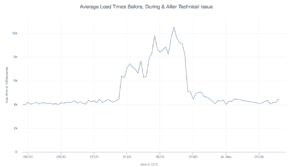
Roy Rosinnes, Co-founder & CEO, Shoppimon
Outages and slowdowns are among the biggest risks today for online retailers and brands—and recent events show that even industry stalwarts like Google are susceptible to problems affecting retailers, because of the intricate connections between retailers and ads.
DoubleClick for Publishers has suffered five service disruptions in 13 days in March, according to ZDNet. One of the biggest disruptions was spotted by my company Shoppimon on March 13. Shoppimon’s AI-powered e-commerce monitoring bots detected slowdowns across all of the stores they were monitoring via their European servers. We alerted Google immediately, Google acknowledged problems with multiple systems and eventually resolved the issues seven hours later. Here is a visual of the average full load time across all sites Shoppimon monitors in minutes before, during, and after the slowdown Time are shown in UTC, which is the time in the United Kingdom, previously known as Greenwich Mean Time):

You’ll notice a spike in full load time during the slowdown. Why does this matter to retailers? According to Aberdeen Group, for every second lost on load time speed, there is a 7% drop in conversion rate for online retailers. This incident also highlights an important increased dependency: no retail site can operate today without embedding third-party services. Tracking conversion rates of ads, for example, cannot be done without embedding Google’s code. Embedding third-party code is usually easy and convenient and can solve a lot of problems. However, this comes at a cost: as your site becomes more and more dependent on services beyond your control.
Here are three tips for online retailers on how to identify and respond to issues rapidly, protect the user experience, and minimize potential losses in revenue during the next (imminent) outage:
1. Before implementing a new tool on your site, have a clear understanding of how every third party embedded within your site can affect its performance. While some third-party integrations run only after a page on your site has fully loaded, meaning that even if they break down, they won’t affect user experience, others will have a direct impact on either interactive time (the point when a user can initially engage with a web page) or full load time (the point when all page content is fully loaded). Most chat widgets are a great example of third-party tools that load only once all other page content has loaded, meaning that if they experience an outage, a shopper’s experience on your site, won’t be affected at all. In the case of Google Adwords tracking, an outage unfortunately has a direct impact on full page load time.
2. Once your site and third-party integrations are live, monitoring, or observability into how your site is doing from an end-customer’s perspective is crucial. Make sure you have implemented a system that will alert you when user experience is being affected in your e-commerce store. Whether issues are technical or content-related, they stand to immediately impact your sales, so discovering them in real time, providing you with the opportunity to act right away, is a must.
3. When a problem hits, having a solid contingency plan for such cases, can potentially save tens of thousands of dollars in revenue for even a single incident. And when something does go wrong, the first question you should ask yourself is: “Can the root cause of the issue be removed without breaking my site?” If the answer is no, then, wherever possible, I’d recommend finding an alternative, as being entirely dependent on a third party you have no control over is highly risky. However, if the answer to that questions is yes, as would be the case with a problem like what we saw with Google Adwords tracking, simply make sure your team is able to quickly remove an integration until it is fixed.
This incident caused by DoubleClick resulted in slowdowns affecting retail sites throughout Europe and the U.S. And with severe performance changes like these dramatic drops in e-commerce conversion rates are a proven result. Additionally, it is important to note that this 3rd party failure was just one of tens or hundreds of integrations on an e-commerce site that can break at any time. Moreover, it happened to Google, a comparatively safe integration that rarely fails, while many others can and do, oftentimes driving a far greater impact.
This is why monitoring, or observability into how your site is doing from an end-customer’s perspective is crucial: being able to get an alert and identify the root cause of such a slowdown in time, and having a solid contingency plan for such cases, can potentially save tens of thousands of dollars in revenue from even a single incident.
Shoppimon provides website monitoring services for online retailers.